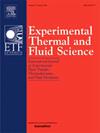Genetically-based active flow control of a circular cylinder wake via synthetic jets
IF 2.8
2区 工程技术
Q2 ENGINEERING, MECHANICAL
Experimental Thermal and Fluid Science
Pub Date : 2024-11-23
DOI:10.1016/j.expthermflusci.2024.111362
引用次数: 0
Abstract
The present work investigates the use of Machine Learning methods for optimizing the control of the wake behind a circular cylinder with the aim of reducing the associated aerodynamic drag using a single synthetic jet located at the rear stagnation point. Initially, a parametric study on sinusoidal shapes is performed to assess the control authority of the synthetic jet and to identify suitable initial configurations for the subsequent optimization study. This optimization leverages gradient-enriched Machine Learning (gMLC), which is based on Linear Genetic Programming, to determine the optimal waveshape for the input driving signal to the synthetic jet actuator, aiming at aerodynamic drag reduction. Machine Learning is thus exploited to overcome limitations inherent to canonical waveshapes. All the experiments are performed at a Reynolds number . Four different optimization runs are conducted to study the effect of increasing the complexity of the genetic recombination process and including a power penalty in the cost function on the control effectiveness. The maximum drag reduction is achieved when no penalty for the power consumption is included in the cost function and amounts to 9.77% with respect to the baseline case. The addition of the power penalty results in control laws comparable in both waveshape and performance to the canonical sinusoidal control laws. In the second part of this work, the ML-derived control policies are investigated via hot-wire anemometry and Particle Image Velocimetry (PIV) to understand and characterize the mechanisms responsible for the drag reduction and the control effects on the wake evolution. For this purpose, a modal analysis based on Proper Orthogonal Decomposition is performed to comparatively assess the control laws and evaluate their capability of weakening and mitigating the most energetic flow structures associated with the vortex shedding phenomenon.
通过合成射流对圆筒形尾流进行基于基因的主动流动控制
本研究采用机器学习方法对圆柱体后方的尾流进行优化控制,目的是利用位于后停滞点的单个合成射流减少相关的气动阻力。首先,对正弦形状进行参数研究,以评估合成射流的控制能力,并为随后的优化研究确定合适的初始配置。该优化利用基于线性遗传编程的梯度丰富机器学习(gMLC)来确定合成喷气致动器输入驱动信号的最佳波形,目的是减少气动阻力。因此,机器学习被用来克服典型波形固有的局限性。所有实验均在雷诺数 Re=1.9×104 的条件下进行。进行了四次不同的优化运行,以研究增加基因重组过程的复杂性以及在成本函数中加入功率惩罚对控制效果的影响。当成本函数中不包含功耗惩罚时,阻力降低幅度最大,与基线情况相比达到 9.77%。增加功率惩罚后,控制法则在波形和性能上都可与正弦控制法则相媲美。在这项工作的第二部分,通过热丝风速测量法和粒子图像测速仪(PIV)对 ML 衍生的控制策略进行了研究,以了解和描述造成阻力减少的机制以及对尾流演变的控制效果。为此,基于适当正交分解进行了模态分析,以比较评估控制法则,并评估其削弱和减轻与涡流脱落现象相关的高能流动结构的能力。
本文章由计算机程序翻译,如有差异,请以英文原文为准。
求助全文
约1分钟内获得全文
求助全文
来源期刊

Experimental Thermal and Fluid Science
工程技术-工程:机械
CiteScore
6.70
自引率
3.10%
发文量
159
审稿时长
34 days
期刊介绍:
Experimental Thermal and Fluid Science provides a forum for research emphasizing experimental work that enhances fundamental understanding of heat transfer, thermodynamics, and fluid mechanics. In addition to the principal areas of research, the journal covers research results in related fields, including combined heat and mass transfer, flows with phase transition, micro- and nano-scale systems, multiphase flow, combustion, radiative transfer, porous media, cryogenics, turbulence, and novel experimental techniques.
 求助内容:
求助内容: 应助结果提醒方式:
应助结果提醒方式:


